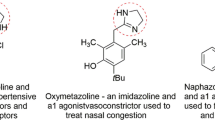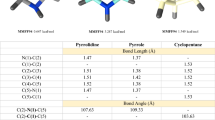Abstract
The title compound, C8H9N3O4S × 1/2(H2O), which is an impurity found in a drug lamivudine, crystallizes in the hexagonal space group P62 with a = 10.208(1) Å and c = 18.073(2) Å. Such a rare packing is constructed by the hierarchical network of hydrogen bonds, which connect the molecules into chains, then into pairs of chains, and neighboring chains, oriented at the angle of 60°, make the final packing mode. The molecule exists in the crystal as the zwitterion, with negative charged carboxylate and positive ammonio groups. The oxathiolane ring is close to an envelope conformation, and both pyrimidine and carboxylate substituent are in the equatorial positions.
Graphical Abstract
The hexagonal packing is constructed by the hierarchical network of hydrogen bonds, which connect the molecules into chains, then into pairs of chains, and neighboring chains, oriented at the angle of 60°, make the final packing mode.

Similar content being viewed by others
Avoid common mistakes on your manuscript.
Results and Discussion
Lamivudine (which is a common name for 4-amino-1-(2R, 5S)-[2-(hydroxymethyl)-l,3-oxathiolan-5-yl]pyrimidin-2(1H)-one) is a reverse transcriptase inhibitor used in the treatment of HIV infection alone or in combination with other class of Anti HIV drugs. It is an antiretroviral agent, which belongs to a class of drugs called “nucleoside reverse transcripts inhibitors” or “NRTIs”. The drug is marketed by GlaxoSmithKline with the brand names Zeffix, Heptovir, Epivir, and Epivir-HBV. Lamivudine and its hydrate have been studied [1]. The identification of lamivudine conformers by Raman scattering measurements and quantum chemical calculations is reported [2]. Lamivudine acid—or 5-(4-amino-2-oxopyrimidine-1(2H)-yl)-1,3-oxathiolane-2-carboxylic acid is an impurity which can be present in the drug lamivudine. In view of the importance of lamivudine, the paper reports the synthesis and crystal structure of lamivudine acid, C8H9N3O4S, which turned out to crystallize in a zwitterionic form, and additionally as a hydrate (I, Scheme 1).
Figure 1 shows the perspective view of the molecule, and Table 1 lists the relevant geometrical parameters. In the crystal structure the molecule of lamivudine acid exists as the zwitterion, with carboxylate anionic and ammonio cationic groups on the opposite ends of the molecule. This is proven by the bond lengths pattern: almost equal C–O bonds, short C9–N91 bond (cf. Table 1). The bond lengths and angles pattern is similar to that found in the structure of Lamivudine saccharinate [3], which might be regarded as an additional proof for the protonation site in the six-membered ring.
Anisotropic ellipsoid representation of the compound I together with atom labelling scheme [12]. The ellipsoids are drawn at 50% probability level, hydrogen atoms are depicted as spheres with arbitrary radii, hydrogen bond is shown as the dashed line
The conformation of the oxathiolane ring is close to an envelope, with four atoms: S1, C2, O3 and C5 almost coplanar (maximum deviation from the least-squares plane of 0.033(2) Å) while the fifth atom (C4) is significantly, by 0.608(5) Å out of this plane. Also the asymmetry parameter [4], which describes the deviation from the ideal symmetry (in this case C s ), has relatively low value of 8.8°. Similar conformation was observed in the majority of the structures with not fused oxathiolane rings found in the Cambridge Structural Database [5], however different atoms occupy the out-of-plane position. The pyrimidine substituent (which is approximately planar, within 0.010(2) Å) occupies the equatorial position with respect to the oxathiolane ring (C2–O3–C4–N6 torsion angle is 172.9 (3)°, S1–C5–C4-N6—160.8 (3)°), the position of carboxylate group is also close to the equatorial one (C4–O3–C2–C21—149.6(3)°, C5–S1–C2–C21—125.3(3)°).
Compound 1 crystallizes in a rather uncommon space group P62—in the CSD there are only 61 structures in either P62 or P64 space groups, of which 26 are of organic compounds. The crystal packing is determined mainly by an extensive network of hydrogen bonds (Table 2), both strong (N-H···O(carboxylate), O(water)–H···O(carboxylate)) and weak (C–H···O(water, carbonyl)). The organization of the three-dimensional network may be analyzed as the step-by-step construction of the six-fold screw symmetry. At the first level, molecules are connected by means of two different hydrogen bonds: N8–H8···O23(x, y − 1, z) and N91–H91A···O22(x, y − 1, z) into the infinite chains expanding along y direction (Fig. 2a). Using the graph-set notation [6, 7] one could find, at this level, two parallel chains C(9) and C(11) along y, which give rise to the second-order R 22 (8) ring. The neighboring chains are connected by hydrogen bonds with water molecules (which lie on the twofold axes) into the pairs of antiparallel chains; the “linking” graph symbol is R 46 (30), cf. Fig. 2b.
Then, at the next level, these double strands are linked by means of N91–H91B···O23 (y, −x+y, z − 1/3) hydrogen bonds with the subsequent strands, which are oriented at the angle of 60° to the former one (Fig. 2c). At this level relatively short and directional C5–H5···O1Wiii hydrogen bonds also play their part, by linking the neighbouring chains. Altogether, all these steps lead to the hexagonal symmetry as seen in the packing diagram (Fig. 3).
The packing diagram as seen along c-direction [13]
Experimental
Preparation
L-menthyl-5-cytosin-1,3-oxathiolane-2-carboxylate(2.0 g, 5.2 mmol) was added to a solution of KOH (0.3 g, 6.0 mmol) in 20 ml of methanol (Scheme 2). The mixture was stirred for 4 h. Methanol was distilled out and the residue was diluted with water. Aqueous layer was extracted with ethyl acetate. The pH of aqueous layer was adjusted to four using acetic acid. The solid was collected by filtration and further recrystallized from water (m.p.: 311–313 K).
Crystallography
Colourless block-like crystal (0.2,0.1,0.1 mm) was used for data collection. Diffraction data were collected at 100(1)K by the ω-scan technique up to 2θ = 60°, on an Xcalibur diffractometer [8] with graphite-monochromatized MoKα radiation (λ = 0.71073 Å). The temperature was controlled by an Oxford Instruments Cryosystems cooling device. The data were corrected for Lorentz-polarization and absorption effects [8]. Accurate unit-cell parameters were determined by a least-squares fit of 2307 reflections of highest intensity, chosen from the whole experiment. The structures were solved with SIR92 [9] and refined with the full-matrix least-squares procedure on F2 by SHELXL97 [10]. Scattering factors incorporated in SHELXL97 were used. The function Σw(∣Fo∣2−∣Fc∣2)2 was minimized, with w−1=[σ2(Fo)2 + 0.0951·P2 + 0.2763·P] (P = [Max (F 2o , 0) + 2F 2c ]/3). All non-hydrogen atoms were refined anisotropically, hydrogen atoms were put in the idealized positions (only that from water molecule was found in the difference Fourier map), and refined as riding model. Their isotropic thermal parameters were set at 1.2 times Ueq’s of appropriate carrier atoms. There are cavities on the two-fold axis which appeared to be filled by highly disordered water molecule; relatively satisfactory results were obtained with half occupancy, but the displacement parameters were very large. Therefore, we decided that the disorder is so severe that in fact it is smeared-out electron density. As an alternative strategy, the SQUEEZE function of PLATON [11] was used to eliminate the contribution of the electron density in the solvent region from the intensity data. The use of this strategy and the subsequent solvent-free model produced better refinement parameters and more precise geometric parameters, than the model with the disordered water molecule. Relevant crystal data are listed in Table 3, together with refinement details.
CCDC-753804 contains supplementary crystallographic data for this paper. These data can be obtained free of charge via www.ccdc.cam.ac.uk/data_request/cif, by e-mailing data_request@ccdc.cam.ac.uk, or by contacting The Cambridge Crystallographic Data Centre, 12 Union Road, Cambridge CB2 1EZ, UK.
References
Harris RK, Yeung RR, Lamont RB, Lancaster RW, Lynn SM, Staniforth SE (1997) J Chem Soc., Perkin Trans 2:2653
Pereira BG, Vianna-Soares CD, Righi A, Pinheiro MVB, Flores MZS, Bezerra EM, Freire VN, Lemos V, Caetano EWS, Cavada BS (2007) J Pharm Biomed Anal 43:1885
Banerjee R, Bhatt PM, Ravindra MV, Desiraju GR (2005) Cryst Growth Des 5:2299
Duax WL, Norton DA (1975) Atlas of steroid structures. Plenum, New York, pp 16–22
Allen FH (2002) Acta Cryst B58:380
Etter MC, MacDonald JC, Bernstein J (1990) Acta Cryst B46:256
Bernstein J, Davis RE, Shimoni L, Chang N-L (1995) Angew Chem Int Ed Engl 34:1555
Oxford Diffraction (2009) CrysAlis PRO (Version 1.171.33.36d). Oxford Diffraction Ltd, Yarnton, Oxfordshire
Altomare A, Cascarano G, Giacovazzo C, Gualardi A (1993) J Appl Cryst 26:343
Sheldrick GM (2008) Acta Cryst A64:112
van der Sluis P, Spek AL (1990) Acta Cryst A46:194
Siemens (1989) Stereochemical workstation operation manual. Release 3.4. Siemens Analytical X-ray Instruments Inc, Madison, Wisconsin, USA
Macrae CF, Bruno IJ, Chisholm JA, Edgington PR, McCabe P, Pidcock E, Rodriguez-Monge L, Taylor R, van de Streek J, Wood PA (2008) J Appl Cryst 41:466
Acknowledgments
CSC thanks University of Mysore for research facilities.
Open Access
This article is distributed under the terms of the Creative Commons Attribution Noncommercial License which permits any noncommercial use, distribution, and reproduction in any medium, provided the original author(s) and source are credited.
Author information
Authors and Affiliations
Corresponding author
Rights and permissions
Open Access This is an open access article distributed under the terms of the Creative Commons Attribution Noncommercial License (https://creativecommons.org/licenses/by-nc/2.0), which permits any noncommercial use, distribution, and reproduction in any medium, provided the original author(s) and source are credited.
About this article
Cite this article
Dutkiewicz, G., Chidan Kumar, C.S., Yathirajan, H.S. et al. 5-(4-Ammonio-2-Oxopyrimidine-1(2H)-yl)-1,3-Oxathiolane-2-Carboxylate (lamivudine acid) Semihydrate: The Six-Fold Symmetry Created by Hydrogen Bond Network. J Chem Crystallogr 41, 214–218 (2011). https://doi.org/10.1007/s10870-010-9866-8
Received:
Accepted:
Published:
Issue Date:
DOI: https://doi.org/10.1007/s10870-010-9866-8









